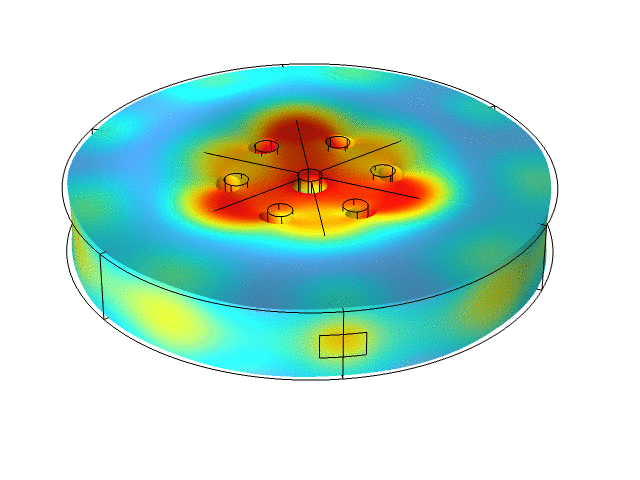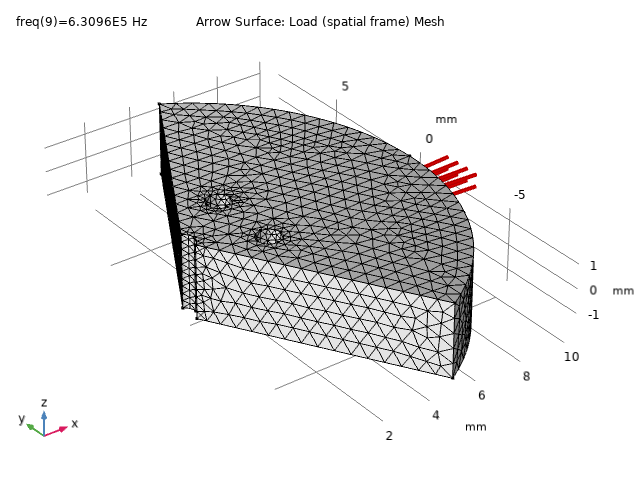Multiphysical simulation methods (in particular finite element calculations) and electrical network models are used in a variety of ways in the "Applied Materials Mechanics and Solid-State Transducers" group. Among other things, they are used to support the characterization of components and materials as well as the development and optimization of measurement technology, piezoelectric actuators and ultrasonic systems. In addition, there is extensive know-how in the development and application of highly specialized methods for the simulation and optimization of steps in the ceramic process chain.
Modeling and simulation
Topic
Acoustic simulations
Acoustic simulations are used in particular for the development of ultrasonic systems and as a supporting tool for characterizing the properties of piezoelectric transducers and materials. Two-dimensional and three-dimensional finite element methods, point source synthesis methods and one-dimensional models (network model-based approaches, in-house Laplace transform-based model) are used for this purpose.


Simulation of ultrasonic excitation of a perforated disk to improve fluid mixing in the holes through which the fluid flows.
Ferroelectric models
Ferroelectric materials are used in a variety of ways in capacitors, electronic memory elements and piezoelectric transducers, including ultrasonic transducers. The precise description of the highly non-linear material behavior of these materials is of great importance for application-specific optimization and the development of new applications. Various modeling tools are available at Fraunhofer IKTS for this purpose, which allow simulations from the micro to the macro scale. These can be used, for example, to simulate the poling processes of ferroelectrics and optimize component geometries with regard to various parameters.



Simulation of the poling of a ferroelectric fiber using notch electrodes and optimization of the notch depth with regard to the piezoelectric properties: (a) Geometric arrangement, (b) Simulated distribution of the remanent polarization, (c) Calculated piezoelectric coupling as a function of the notch depth.
Further publications
- A hybrid phenomenological model for ferroelectroelastic ceramics. Part I: Single phased materials
- A hybrid phenomenological model for ferroelectroelastic ceramics. Part II: Morphotropic PZT ceramics
- Some aspects of macroscopic phenomenological material models for ferroelectroelastic ceramics
- Poling Technologies and Design Optimization for Integrated Piezoelectric Bulk Transducers and Piezoelectric Composites
Simulation of sintering processes
The process control during the sintering of large or complex components has a decisive influence on the reliability of the manufactured components and the manufacturing efficiency. The optimization of sintering processes therefore plays a decisive role. However, due to the large number of influencing factors, a purely experimental approach involves a great deal of effort. Simulations can significantly reduce this effort. For this reason, Fraunhofer IKTS has developed methods for the model-based optimization of sintering processes.

An indispensable basis for carrying out model calculations is the characterization of the relevant material properties. For this purpose, an experimental methodology was developed with which the required data can be recorded with minimal effort. An essential part of this is the determination of the material-specific shrinkage curves as well as the thermal and elastic material properties.

In the actual simulation, not only is the sintering process of the component modeled using the finite element method, but the influence of the sintering furnace itself is also taken into account. The often significantly inhomogeneous temperature fields in the sintering furnace and in the components to be sintered lead to both inhomogeneous shrinkage behavior and mechanical stresses. This situation is taken into account with a thermodynamically and kinematically consistent material model developed at Fraunhofer IKTS. Based on this, model calculations can be used to simulate and optimize sintering processes.


Services offered
- Multi-physical simulations (mechanical, electrical, magnetic, thermal fields)
- Acoustic simulations
- Simulation of the nonlinear material behavior of ferroelectrics and optimization of poling processes including resulting piezoelectric properties
- Simulation and optimization of the sintering process of ceramic materials
- Customized development of simulation tools for the ceramic and functional ceramic process chain